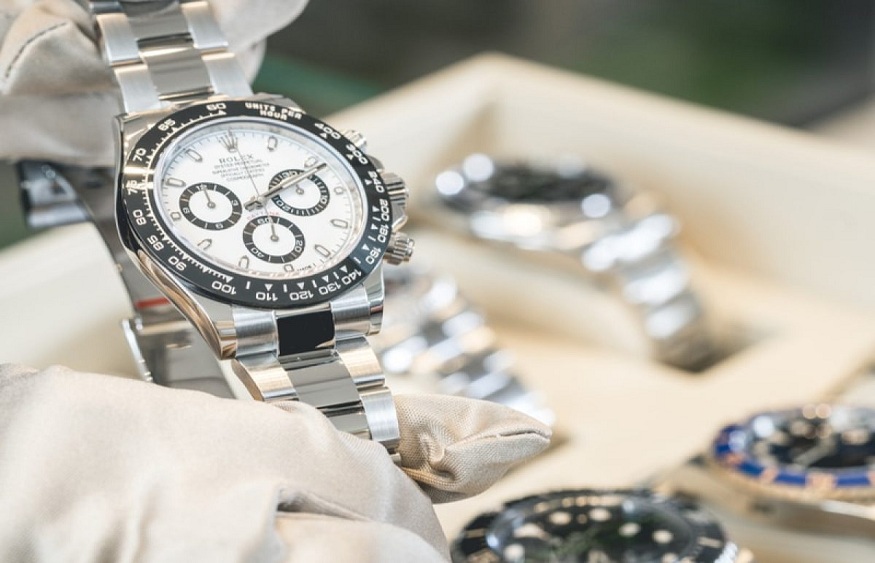You can tell a lot about a Rolex by its crown not that one
Like a fingerprint, every Rolex watch has a few little identifiers that tell you about it. There’s the serial number, of course, which used to be sequential, but is now just a string of random letters and numbers that keep customers from knowing if a watch has been lying around in a jeweler’s window. You will agree with me that this question is no longer of great concern these days.
But this is not the only element that Rolex has left on its watches. Like the Omega logo stamped on its Hesalite-equipped Speedmasters, Rolex has taken to engraving a small Rolex crown into its crystals. It’s actually a miniaturized version of those super fancy laser etched glass ornaments you see for sale in malls, barely visible and there more for Rolex than for you.
This little crown-shaped logo started appearing in the new millennium, except for the green glass Milgauss, which goes without. It is not a solid engraving, but a multitude of small dots that trace the outline of the famous crown logo. The purpose of this almost invisible marking? It is a symbol of authenticity, too difficult for counterfeiters to reproduce faithfully, but it is not for lack of trying.
But that’s not all, because the laser-engraved crown also hides small messages. Look into the hole where the crown would sit on its wearer’s head, and you might notice a letter “S” on the side. If so, the crystal was replaced during an overhaul. It’s not a negative thing, but it’s there to let Rolex know that this operation has been performed.
More recently, Secret Crown Messages have been expanded to tell you what type of crystal it is. Rolex didn’t previously use anti-reflective coatings — like those found on bezels — but now they do, and you can tell what type of glass your watch has by the small engraved crown by laser. If you only have one ellipse at the bottom, it means there is no coating or only on the magnifying glass; a double ellipse and a coating on the underside of the lens; a double ellipse with a line in the middle, and you have coating on both sides. It’s the confusion of anti-reflective coatings presented in a clear and clean way!
The Rolex Daytona Doesn’t Look Like You Think
Rolex’s signature figure, the Cosmograph Daytona, was the brand’s first real hit of the modern era, turning a dismal model into a two-plus-year waiting list. The story of transforming a watch that couldn’t be given away into a watch that made people literally millionaires has made the Daytona one of the most well-known and analyzed watches of all time.
With a pen and a sheet of paper, I think it’s safe to say that many of us could draw one from memory with a reasonable degree of accuracy. Take the new — lines of text on the dial. Easy.
But what if I told you that no matter how hard you try, you’re going to get the case design wrong? For starters, most of the case is hidden except for the previously mentioned crown guards and symmetrical top and bottom lugs.
But here’s the thing…the horns aren’t symmetrical. The horns on the left are thicker than those on the right. Not by much, but enough to notice. This phenomenon occurs on all steel and bimetal models. Precious metal cases are different and effectively symmetrical, but anything steel has more metal on the left lug than the right. For what ? To balance the visual weight of the pushers and the crown. Unfortunately, once you’ve seen it, you can’t forget it. Sorry !
Rolex failed to become an independent company
What do you look for when it comes to choosing a watch brand? For most people, it’s a household name, high quality, solid history, and most importantly, in-house production. The more demanding enthusiasts we have become, the more importance we have attached to the ability of a watchmaker to manufacture the entire watch himself.
Now, between you and me, it’s not a question of history. Even in the days of pocket watch makers, there were companies that made movements, companies that made cases, companies that made dials, and companies that put it all together and put their name on the watch. packaging.
And when watches went from pocket-sized to wrist-sized, this behavior only got stronger. Even big names like Patek Philippe have used movements made elsewhere, focusing instead on expertly finishing them to a level worthy of the Patek Philippe name. The notion of in-house manufacturing is as historically correct as the rarity of diamonds.
There were, however, companies that dominated the industry and effectively made everything themselves. For example, Omega, a brand that really established the idea of producing high quality watches, under one roof. She was doing it decades before Rolex even existed.





